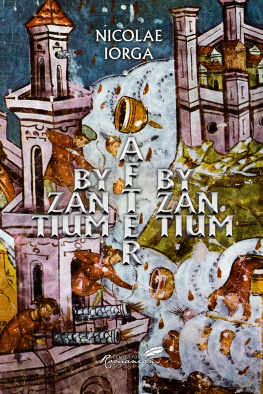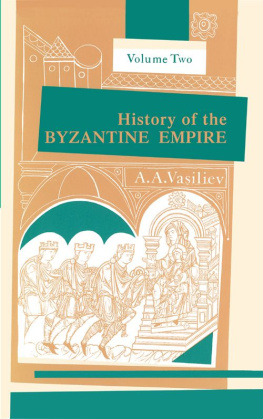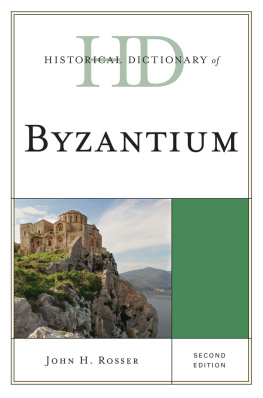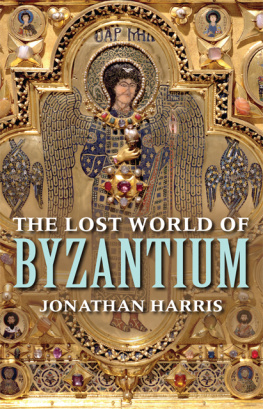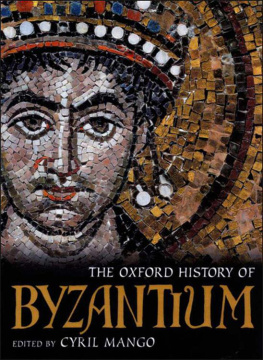
A CONCISE HISTORY OF BYZANTIUM
Warren Treadgold, under exclusive licence to Macmillan Education Limited 2001, 2020
All rights reserved. No reproduction, copy or transmission of this publication may be made without written permission.
No portion of this publication may be reproduced, copied or transmitted save with written permission or in accordance with the provisions of the Copyright, Designs and Patents Act 1988, or under the terms of any licence permitting limited copying issued by the Copyright Licensing Agency, Saffron House, 610 Kirby Street, London EC1N 8TS.
Any person who does any unauthorized act in relation to this publication may be liable to criminal prosecution and civil claims for damages.
The author has asserted his right to be identified as the author of this work in accordance with the Copyright, Designs and Patents Act 1988.
First published 2020 by
RED GLOBE PRESS
Red Globe Press in the UK is an imprint of Macmillan Education Limited, registered in England, company number 0175588, of 4 Crinan Street, London, N1 9XW.
Red Globe Press is a registered trademark in the United States, the United Kingdom, Europe and other countries.
ISBN 978-1-352-00989-7 hardback
ISBN 978-1-352-00987-3 paperback
This book is printed on paper suitable for recycling and made from fully managed and sustained forest sources. Logging, pulping and manufacturing processes are expected to conform to the environmental regulations of the country of origin.
A catalogue record for this book is available from the British Library.
A catalog record for this book is available from the Library of Congress.
In memory of
my mother
Alva Granquist Treadgold
Contents
List of Maps and Table
Maps
Table
List of Figures
Preface
This revised edition reflects some developments in Byzantine studies since the original edition of 2000 but still draws heavily on the research I did for my longer History of the Byzantine State and Society (1997) and Byzantium and Its Army (1995). For this edition, I have also added ten more maps, a new chronological table, and new sections on sources that draw on my Early Byzantine Historians (2007), Middle Byzantine Historians (2013), and Later Byzantine Historians (in progress). Anyone who wants more detail or fuller references, including footnotes, should put this book down right away and turn to the others. While I try to make all my books accessible to general readers and students as well as to scholars, naturally this one is meant for readers with less time or a less specialized interest in Byzantium.
Apart from the introduction and conclusion, each of the books chapters begins with a narrative account and ends with descriptive sections on society, culture, and sources. Given the fashions of modern academic writing, some scholars might have liked this book better if I had left out all the narrative and simply reprinted the third of my History of the Byzantine State and Society that covers social and cultural history. But the result, even with some added explanations, would have been hard for readers unfamiliar with Byzantium to follow and still could not have been a comprehensive treatment of Byzantine civilization, which would require a fully topical organization like that of Cyril Mangos Byzantium: The Empire of New Rome (1980). Of course, readers with no interest in narrative, like those interested only in narrative or interested only in one period, can read just the parts of either book that interest them.
On the other hand, such preferences can be more than a matter of taste, because the Byzantine state and Byzantine society constantly interacted. For example, the demographic, economic, and cultural crisis of the sixth century led to the political, military, and religious upheavals of the seventh and eighth centuries, which in turn led to the social, economic, and cultural revival of the ninth century. Some of the best work done in Byzantine history in the last fifty years has demonstrated such connections. Yet they are barely discernible in many earlier surveys, including George Ostrogorskys History of the Byzantine State, first composed in 1938 and largely based on scholarship from before 1914, or the popularizations of John Julius Norwich, largely based on the eighteenth-century work of Edward Gibbon. I shall be delighted if this book can persuade some narrative history buffs of the value of social and cultural history or a few social and cultural historians of the value of historical narrative.
Warren Treadgold
St. Louis, MO, USA
Introduction
THE PROBLEM OF DECLINE
In AD 285, the emperor Diocletian divided the Roman Empire into two parts. The eastern part, the subject of this book, became known as the Eastern Roman Empire or, after the last of the Western Empire disappeared in 480, simply as the Roman Empire. Only after the former Eastern Empire also fell in 1453 did some scholars feel a need for a name without Roman in it for an empire that had not included Rome. Although the capital of the East had usually been at Constantinople, the term Constantinopolitan Empire was ungainly. The renamers settled on Byzantine Empire or Byzantium, Byzantium having been the name of the small town refounded as Constantinople in 324. For better or worse, this name has stuck, though historians disagree about the right date to start using it. This book begins with 285, when the Eastern Roman Empire began its separate existence, but the town of Byzantium had no special importance as yet. I avoid calling the empire Byzantine until the fifth century, when Constantinople truly became its political and cultural capital and the Western Roman Empire fell away.
Under any name, the Eastern Roman Empire has a long-standing reputation for decadence. This is partly the doing of Edward Gibbon, who (without calling it Byzantium) made it the subject of his magnificent Decline and Fall of the Roman Empire. Ever since a Calvinist minister hired by his father talked him out of his youthful conversion to Roman Catholicism, Gibbon was disillusioned with Christianity and looked down on Byzantium as a Christian society. He knew that the Western Roman Empire had fallen soon after becoming mostly Christian and that, even if the Eastern Empire had lasted a millennium more, it too had fallen in the end. Besides, to someone with a Classical education like Gibbon, Byzantium looked like a degenerate mongrel of Greece and Rome that had lost the city of Rome and spoke bad Greek. Moreover, the whole medieval period, when Byzantium existed, was in his opinion a dark and barbaric age.
Neither Gibbon nor others ever developed such prejudices into a rigorous argument. While a small fraction of Byzantine history was a relatively dark age, Byzantine culture was always well in advance of that of contemporary Western Europe. Although the Greek language evolved over time, as it had done since Homer and as every language does, the best Byzantine scholars were excellent Hellenists who could read and write ancient Greek very well. Whatever we think of Christianity, it was no less intellectually respectable than the combination of the Olympian gods and mystical Neoplatonism that it replaced. The Eastern Empire, which had first been separated from Rome by an administrative decision rather than a military defeat, later conquered Rome and held the city for some two centuries. Finally, that Byzantium fell in the end seems less striking than that it lasted for well over a thousand years.
Next page


